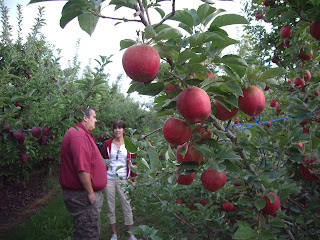He told us they harvest a few days earlier than the standard Honeycrisp because they color faster. They're more acidic than standard Honeycrisp with an ideal brix of 10 or 11. These were ready for harvest any day.The plan was to pick these trees soon so they would store until May 2012. No extra calcium or Mylar needed. Standard Honeycrisp needs extra calcium to prevent bitterpit and Mylar to promote color. The Jones' overhead cooled when it was hot last summer and fall.
I asked Jim how this variety originated? He said that the orchard owner, Brian Jones, noticed that one limb on a grafted Sanza had outstanding color. Jones grafted that limb to 5 trees in his fugi block.
The 5 trees we were looking at were almost identical. They had all come off the same limb.
Jim told us the Royal Reds are patent approved. However, the DNA report is pending. They have one or 2 markers different than the standard Honeycrisp. Jim thought trees would be available for purchase through Willow Drive Nursery 2017-2018 at the going rate or maybe $3.00/tree; $1.50 royalty & $1.50 propogation rights if we grow our own.So you're dying to know our reaction? The color was consistent and good, but not the kind of outstanding we expected. We wondered why these trees were removed from the other Honeycrisps? We would have liked to visually compare them to the other Honeycrisps managed by the Jones'. As I mentioned before it looked like management practices could account for at least some of the good color we observed. Keeping the trees low in vigor, good crop load management and pruning in summer have a big color impact on Honeycrisps.






No comments:
Post a Comment